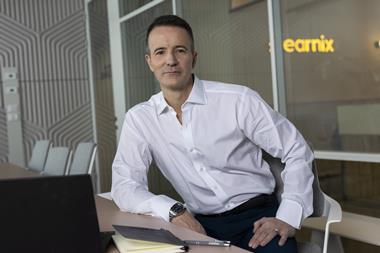Insurance Times’ head of research Savan Shah speaks to Simon Bloomfield, head of Imarket at Polaris, about how brokers can stay relevant and who will be the future winners in commercial insurance
The Insurance Times Etrading Survey 2022 is open to UK brokers.
If you are a broker, please take part in this year’s survey before 20 March 2022 to help influence the future of etrading.
While the survey is open, Insurance Times will be speaking to industry leaders who are heavily involved in etrading, to discuss sector developments.

Here, Insurance Times catches up with Polaris’ head of Imarket Simon Bloomfield.
What areas have Polaris been working on over the last 12 months and what developments will take place over the next year?
Polaris’ role is to help the insurance market digitally trade more effectively, so our developments are supporting our wide customer base of over 100 insurers, MGAs and system providers to do that.
Around 112 organisations now use personal or commercial lines Standards, with some using both. In recent years, our customer base has extended beyond insurance to include organisations from the personal finance sector.
Our rating engine, ProductWriter, is the industry’s leading solution in this area and we continue to further enhance it, especially in its ability to support machine learning models and extended data enrichment capabilities. At the end of 2021, ProductWriter had its highest ever client usage within the industry.
For Imarket, we continue to provide the connectivity that enables eight major insurers to distribute 490,000 policies through four broker systems in 2021.
We have also seen the take up of our live chat solution increase to seven insurers - in 2021, there were over 100,000 chats completed between brokers and Imarket insurers, via brokers’ back office systems. These chats often helped brokers to clarify policies’ terms and conditions on behalf of their customer. We also saw our live chat solution used for another 100,000 chats to support insurers’ business on their own extranets.
In 2022 we expect:
- To develop new Standards for motorhomes in the personal lines market and for claims messaging notifications in the commercial lines market. We will continue to build on our suite of existing product Standards as new market segments are introduced.
- ProductWriter users will benefit from a new release in early Q2 2022, providing sophisticated new approaches to building and maintaining products with general user interface enhancements. This evolves the ease of use capabilities that are fundamental to ProductWriter community. Later in the year, we will be piloting a new approach to rate deployment.
- Imarket remains on track to exceed 500,000 transacted policies, while live chat usage is going to continue to expand. We expect to see insurers potentially adopt more automation into their processes, to allow their service teams more time to focus on challenging questions and risks from brokers.
The 2022 Etrading Survey aims to explore how brokers perceive the referrals process for more complex products. How do you see this developing in the years ahead?
From my discussions with brokers, it is clear that insurer service levels have varied during the pandemic - sometimes this had a knock-on impact on the speed of referrals.
A number of insurers are already automating more decisions for lower value or less complex products. We have seen through the last couple of years how mini fleet and commercial combined product volumes have grown by around 20% and with these more complex products, the role of referrals will evolve.
For example, it wouldn’t make sense to have a 30% referral rate on a tradesman policy, but for a mini fleet or commercial combined product, that might be more appropriate.
This allows for the unique characteristics of individual customer’s businesses to be underwritten at policy inception, leading to a smoother digital process thereafter.
Live chat can also support a broker by reducing the need for broker initiated referrals, as clarifications can be sought outside of the digital process.
Needless to add, the winners in digital trading invariably will be the ones whose products have the widest underwriting footprint, the best terms and conditions and the slickest service model to support it. Referrals are just one piece of that jigsaw.

Many brokers still use both insurer extranets and software houses for their etrading activity. Do you feel this practice will continue or are you seeing a change?
There is a role for both in the market and I know there are some questions in this year’s survey that focus on this topic, so I am looking forward to seeing what brokers say about this.
With extranets, insurers can create their own customer journey and product specifications - but that comes without integration into the brokers’ own systems or the ability for a broker to easily compare multiple insurer products.
On broker systems, there are compromises in the journey to allow brokers to see and compare quotes from multiple insurers. There is an element of trade-off and both have their place.
How can brokers stay relevant in the years ahead?
Brokers will continue to deliver the combined benefits of wider market access and the ability to provide advice to their customers. Many commercial lines risks need an understanding of a client’s unique circumstances and to ensure that the policy is suited to them. This is a function that brokers are well positioned to perform.
At the same time, brokers – like any other service provider – will be expected to offer many of their own services to their customers digitally. These could cover a wide range of areas, such as digital interactions with customers, sales and policy administration assistance or risk management advice that is delivered digitally.
Brokers are well positioned to access a lot of insurers’ products digitally on behalf of their customers and also to digitise parts of their own service delivery. Brokers that blend both of these approaches should be able to improve their own internal efficiency while also meeting their customers’ expectations.
In 2022 to 2023, Polaris will make its largest investment in Imarket’s infrastructure since the platform’s inception in 2003. How will this impact the world of etrading?
Polaris has a sizeable Imarket investment project underway in 2022 to 2023. For brokers, there is very little impact as the investment is focused on futureproofing the Imarket infrastructure by modernising its architecture. This will enable it to scale more effectively to support the continued growth that we expect to see through Imarket over the next five years or more.
How do you see the etrading arena developing over the next five years?
Like most digital offerings, insurance needs to keep evolving. It’s difficult to say whether this will be through evolution or revolution, but I would expect the winners to be those that can continue to make their propositions more customer-centric.
The economy and businesses around us are themselves evolving – some of the occupations and sectors in place now did not even exist or were quite nascent a few years back. Digital insurance offerings need to keep pace with this evolution. The pandemic has focused everyone’s minds on doing more digitally and that applies to all sectors - including insurance.
Certainly, I would expect to see insurers looking to make more of their propositions digital. By that I mean even cases that are manually underwritten then being managed through tech supported underwriters’ desks.
Digital trading is a continuum. Going from electronic submission with manual underwriting, to instant responses and straight-through processing that are more common in the simpler commercial classes. I’d expect insurers and brokers to look for opportunities to keep reviewing and improving how they manage different customer groups along this continuum.
Whether we will see something revolutionary that shakes up the commercial lines market is difficult to say, but I don’t think that possibility can be discounted either. If however, brokers and insurers stay focused on delivering customer-centric solutions, then obviously there are fewer gaps in the market for any disrupter to exploit.














































No comments yet